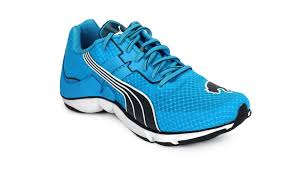Highly expansive in terms of
performance, the new Mobium Elite Speed from PUMA is a performance trainer that
has successfully infused smart, innovative design, style and quality all in one
package. It is the third series of the Mobium elite series, and like the other
shoes it belongs with, the Elite Speed has an adaptive fit technology. This
means the fitting is flexible and can cater to a wide range of foot types. This
shoe initially looks fast and is indeed fast according to its satisfied
testers. It is an award-winning shoe that features a very useful reflective
print. It is widely available in a range of color palettes which prove its
stylishness. It also has been infused with a heavy combination of PUMA’s new
technologies.
Arch support and pronation control
Being a neutral running and
performance shoe, the arch structure and support of the Elite Speed is fairly
sufficient, which mainly supports neutral pronators or supinators.
Terrain
The Elite Speed can be used for a
long range of surfaces or terrains. It can be used on urban city roads, dry
dirt-packed trails, and even on the treadmill at home. What is really good
about the Elite Speed is that it is not restricted in terms of terrain.
 Use
Use
As much as it is versatile on any
kind of terrain, the Elite Speed can also be used for a wide range and
assortment of activities too. Runners will like the fact that it can even be
used as casual wear because of its modern design on the upper.
Durability
In terms of resilience and
durability, the Elite Speed is considered a winner. An award-winning shoe like
this has been proven to be very tough against a lot of naturally caused wear.
Its defining feature, the Mobium technology, extends the life of the shoe much
more aesthetically. It also does not overlap against the other technologies,
which is very essential in a shoe. The “revolutionary” design of this shoe has
been indicated as carefully processed and designed. The encouraged natural foot
movement/motion also contributes to the overall durability of the shoe.
Anything that lessens excessive wear is considered highly helpful to the
resilience of the shoe’s different aspects.
Fit and sizing
Wide-footed runners may actually
be turned off with the narrow design of the Elite Speed’s fit. These wide-footed
runners though, are runners who have bigger foot types than the usual. On the
upside, the adaptive fit technology of the Elite Speed makes it an able shoe
that can easily adapt to a range of foot types; so if these wide-footed runners
will choose to risk buying it, they will still benefit from the shoe. The
sizing is also normal, meaning it comes in sizes available in width D.
Outsole
There are very noticeable
expansion pods on the outsole of the Elite Speed, which provides all of the
cushioning, durability and flexibility needed by the runner. The outsole is
also where the Mobium band is highly utilized, running through the entirety in
an 8 pattern, and works dynamically well with the tendons of the runner’s foot.
What makes the Elite Speed very unique is that the more impact the runner puts
on the landing, the more spring or bounce it returns. Another technology that
completes the outsole of the Elite Speed is the Evertrack technology, the
abrasion-resistant rubber compound found at the high-wear areas of the outsole.
This is then complemented by the Everride Technology, the maximum cushioning
needed for easier toe-off.
Midsole
The Molded PUMA Supreme Ride EVA
sock-liner is found in the midsole of this shoe, completed and enhanced with
flex grooves and a simple arch support. This allows the runner to go on very
smooth, transitional and gradual rides. The underfoot is also sufficiently
protected by the midsole cushioning, where the Mobium technology is highly
utilized.
Upper
The upper of the Elite Speed is a
new design that stretches four-way, which contracts and expands with the
runner’s foot during running. A reflective design technology called the
NightCat has also been used on the upper, so as to aid the runner during
low-light conditions. All in all, the air mesh provides a very breathable
coverage.
Summary
To runners looking for a very
excellent combination of quality and design, the Elite Speed could very well be
their ideal choice. The shoe lives up to its promises, and is truly reliable
and trustworthy in a lot of aspects. So far, there are only slight concerns
that are associated with the shoe, ones that do not usually grow into bigger
problems. The Elite Speed may also still be regarded as a minimal shoe, but it
provides so much more than just minimal feel. Look up retail stores to get your
pair now!
Price
With the kind of technology the
Elite Speed has, the price range does not initially come in an affordable
price. The Elite Speed has primarily been endorsed as a neutral performance
running shoe that has the reasonable price of $130. On the upside, there are
retail stores you can look up online which may sell stocks of the shoe at a
very affordable shoe.









